Over 30 Years of Generosity: A Legacy of Enhancing Understanding of the Arab World
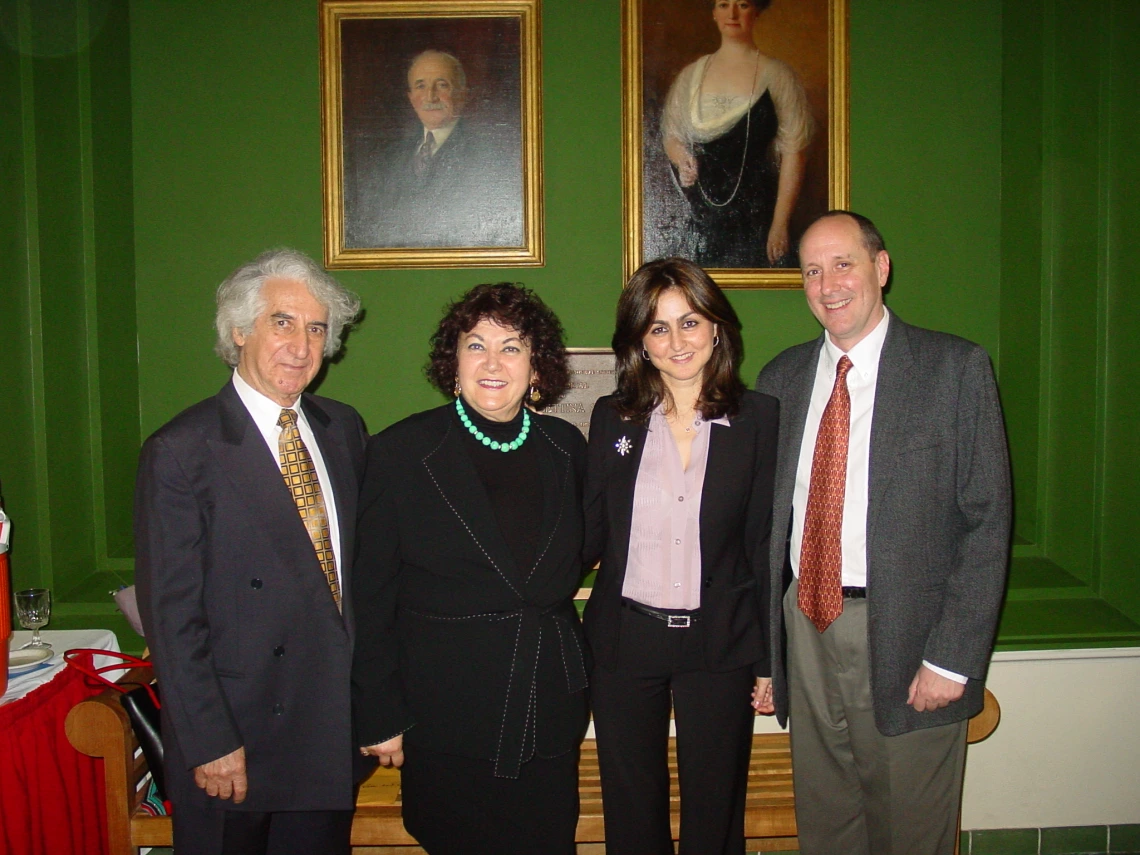
Adib and Vivi Sabbagh, 2005 speaker Zainab Bahrani, John Olsen
In early spring for the last 31 years, the Sabbagh Lecture brochure would arrive in the mail. Printed on thick linen cream paper with rich brown Arabic letters in the border, the distinctive style of the brochure reflected the tone of the lectures – elegant, serious – just like Drs. Entisar “Vivi” Sabbagh and Adib Sabbagh, the lecture series sponsors.

Vivi presented with flowers at the Sabbagh Lecture. To her left is the late Selma Paul Marks. To her right is Professor Juan R.I. Cole, who spoke in 2006 and 2012.
The annual Sabbagh Lecture – held at either the Marriott Tucson or the Arizona Historical Society – was presented by the School of Anthropology and focused on Arab cultures from an anthropological perspective. The lectures drew hundreds of people, enhancing public understanding and appreciation for the complexity and diversity of Arab cultures.
In 2023, Adib passed away at the age of 90. For regular attendees of the lecture, so used to seeing Vivi and Adib devotedly side-by-side, his passing was acutely felt. After much reflection, Vivi made the tough decision that the successful 2024 lecture by Joseph Sassoon, “The Sassoons: The Great Global Merchants and the Making of an Empire,” would mark the end of this impactful series.
Honoring Two Cultures
Vivi and Adib were born in Iraq and lived in several U.S. cities before settling in Tucson in 1971. Adib was a Tucson cardiac surgeon. Vivi obtained her Ph.D. in anthropology from the U of A.
“In anthropology, Vivi found answers to her boundless curiosity about people, their cultures, and their food,” Adib wrote when he honored Vivi in the U of A’s Women’s Plaza of Honor.
Vivi comes from a family that values education. Vivi's father, Gabriel Albanna, was a founder of Iraq's College of Law where he was also a professor. Her mother, Georgette, was talented and multilingual. Vivi and Adib’s sons both earned advanced degrees: Hadil received his Ph.D. in computer science and Marwan completed an MD.
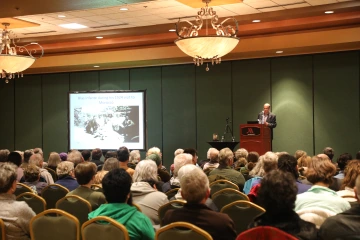
2019 Sabbagh Lecture by Charles Hirschkind on Flamenco and the Rediscovery of Islamic Spain.
Vivi was appalled by how little knowledge many people had about Iraq and the Arab world, “these ancient civilizations.” In 1993, Vivi and Adib decided to create a lecture series, which was modeled after the Marks Lecture in the James E. Rogers College of Law, sponsored by their dear friends – the late Jack Marks and Selma Paul Marks.
“The lecture series was our way to give back to our two cultures – our native culture and our adopted culture,” Vivi says. “We both value education very highly.”
Vivi worked with Bill Longacre, who was head of the then Department of Anthropology, to launch the series. She recalls Longacre saying, “The best war is the war on ignorance.”
“The Sabbagh Lecture brought our community fresh ideas and perspectives about a part of the world about which we often have little access beyond stereotypical narratives and images,” said Diane Austin, director of the School of Anthropology. “The lecturers expanded our knowledge and awareness by sharing rich and varied conditions, experiences, and practices of people and communities from the Arab world.”
“It’s very presumptuous to think a lecture is going to change people’s mind or world view. However, it will introduce a question. Maybe I should know more about this?” Vivi said. “If someone afterwards has gone and read an article or looked up information on the topic, the lecture has done its job.”
A Town and Gown Event
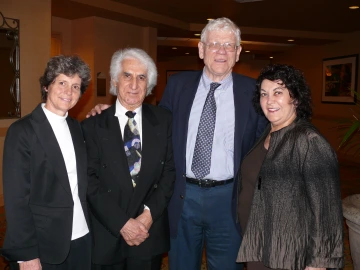
Diane Austin, Adib Sabbagh, 2014 speaker McGuire Gibson, Vivi Sabbagh.
An expert in Arab cultures was brought to campus each year from prestigious universities, including Dartmouth, NYU, Columbia, Princeton, Harvard, the University of Chicago, UC Berkeley, and Yale. One year, a prominent journalist from The New Yorker presented.
The lecturer was selected by a committee, which included Vivi.
“Vivi is herself a committed scholar and has a gift for identifying scholars who are able to speak simultaneously to the academic and public members of a mixed audience,” said Austin.
“I do my homework,” Vivi said. “I do a lot of research on the speaker beforehand.”
Lecture topics have included a range of issues, including justice in the Arab courts, the anthropology of Islam, women in Arab cultures, Muslim politics, representations in media, medieval Arabic science, Arab Detroit, journalism as anthropology, Arab Spring, the new Arab man, history of Iraqi Jewish children, Islamic Spain, healthcare, minoritized narratives, and comics in the Arab world.
Vivi enjoyed them all, recalling, in particular, Harvard Professor Steven C. Caton’s introduction of the movie Lawrence of Arabia at The Loft Cinema in 2016 (as a special supplement to the lecture). She remembered Columbia Professor Zainab Bahrani’s 2005 discussion of the destruction of Iraq’s cultural heritage under occupation as “very moving.”
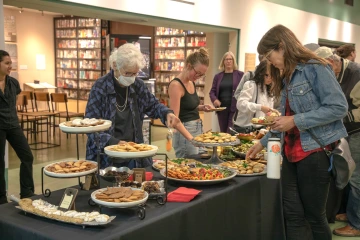
The Sabbagh Lecture was always followed by a free reception.
Following the lecture, attendees would spill out into a reception area where a delicious spread of food and drinks awaited them. Stimulating conversation flowed freely.
“The reception afterwards was the icing on the cake as we had the opportunity to talk with the speaker but also with one another,” Austin said.
Emeritus Regents Professor John Olsen attended 29 of the 31 Sabbagh Lectures. “I enjoyed attending the lectures for both social and academic reasons,” said Olsen, who was the head of Department of Anthropology from 1998 to 2008. “I always learned a great deal, but I also enjoyed the opportunity to interact with the lecturers, my friends and colleagues outside the School of Anthropology, and, of course, members of the Tucson community.”
Olsen added, “To my mind, the Sabbagh Lectures were the dictionary definition of town and gown events. They were of the highest academic caliber but also managed to reach out into the local community. They enhanced understanding of the role of anthropology today and promoted the school's goal of creating new ways for the campus and greater Tucson community to interact.”
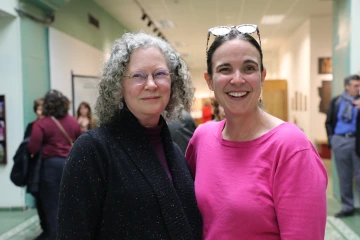
Anne Betteridge, director emeritus of the Center for Middle Eastern Studies (CMES) and member of the Sabbagh lecturer selection committee, and Julie Ellison, associate director of CMES.
Vivi loved to see fresh faces from the community at the lecture but was especially pleased to see students attend. The Sabbagh speaker also met with anthropology graduate students for a master class the day after the lecture.
“When all’s said and done, I wanted the Sabbagh Lecture to influence students,” Vivi said.
In addition to sponsoring the lecture series, Vivi has shown great dedication to the School of Anthropology and the College of Social and Behavioral Sciences. She served on the SBS Advisory Board from 1999 to 2023, and she and Adib were also long-time Innovation Circle patrons. In recognition of her contributions to the school and to anthropology, she was the eighth recipient of the school’s Raymond H. Thompson Award, named in honor of the head of the then Anthropology Department from 1964 through 1980.
“Vivi is a perfectionist, ambitious, generous, and humanitarian in all her instincts. She is totally dedicated to her alma mater, the University of Arizona. Vivi believes in quiet philanthropy particularly giving of herself as a volunteer," wrote Adib Sabbagh, when he honored Vivi in the Women’s Plaza of Honor. "I am in awe of my great and dear friend, my very special human being.”
Both Austin and Olsen credit Vivi for making the Sabbagh Lectures a staple of intellectual life for Tucsonans interested in exploring the richness of Iraq and Arab culture.
“Vivi pays incredible attention to detail and would always make sure that our guests were treated with the utmost kindness and respect,” noted Austin.
Olsen added, “Vivi's and Adib's absolute dedication – one might say devotion – to the planning and execution of the Sabbagh Lectures extended throughout the year and I am indebted to them for allowing me to participate in the process.”
Vivi is likewise grateful for the partnership with the School of Anthropology. Every year she would bring presents to the staff who helped with the event.
“I’m grateful for and have been so impressed with the people I’ve worked with over the years, including John Olsen, Diane Austin, Anne Betteridge [emerita director of the Center for Middle Eastern Studies], various staff – for their commitment to their work and preserving what is good about public lectures and supporting a university that serves the people.”
##
This story was included in the spring 2025 Developments newsletter.

